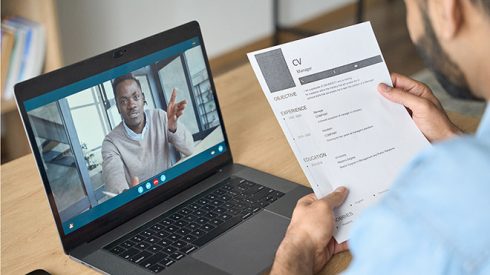
From mask mandates to seeing coworkers and associates through video calls rather than in person, the coronavirus has completely altered the way we work. The way we go about running a business is not exempt from this, as more and more companies transition from in-person workplaces to virtual formats.
There are many benefits and disadvantages to this transformation, and one element of this change is the concept of a virtual interviewing and hiring process when onboarding new employees. The idea of interviews via video calls can seem daunting to both employers and employers alike, but the truth is that digital hiring is quickly becoming the new normal.
Eric Riz, founder of verified data platform Empty Cubicle, says that while seeking out and hiring employees online is not necessarily a new concept, the push for all companies to adopt this practice is stronger now more than ever. “The expectations and the demands on the businesses have become a lot harder. Where organizations had a specific regimented process of how long it would take for an individual to get hired, that has now been modified,” explained Riz. This modification has been fast-tracked with in-person interviewing and hiring not being an option over the last year and a half.
RELATED CONTENT: Developers reflect on challenges, feelings about remote work in pandemic year
An interview process that may have taken two rounds in an in-person format could very well take three or even four while conducting interviews online, because it is harder to get a solid read on candidates while viewing them through a screen. On top of this, some companies that may have favored a more old-fashioned approach to hiring have had to make this shift rather quickly, making it challenging to navigate through this new hiring process.
Not knowing what to expect
In the pre-pandemic world, employers and job seekers knew what to expect going into an interview. Dressing in business casual attire and expecting a firm handshake at the start of the interview was a familiar approach to hiring, but today that is no longer the case. Not only do employers now have to be sure that the candidate being interviewed is right for the job, they also have to ensure that the interviewee is the right person to function effectively through digital means.
“An expectation that everyone knows and uses the technology appropriately, whether they’re using Teams or Hangouts or Zoom or anything else, it means that the hiring [expectation] on the employer’s side has been increased,” Riz said. This shouldn’t come as a surprise; employers expect to have to train new hires on the ins and outs of the business, but when they also have to go through how to effectively use online platforms for everyday tasks, the length of that training process can be extended, making that candidate less desirable. Finding a candidate who is somewhat tech savvy is playing a more important role in the hiring process because businesses that used to use minimal tech to run their day-to-day operations are now becoming increasingly reliant on it.
Another aspect of online interviewing is that of verifying the credentials of the candidate. Before COVID, when interviews would take place in person, an employer could easily tell that the answers being given by the interviewee were their own words and experiences. However, when viewing someone through a screen, it is hard to tell what information they have access to right in front of them. “As I’m sitting here in my home office I have four screens in front of me, and you’re on one of them,” he began, looking at me through the computer monitor. “If I put you on another screen and I had a bunch of technical details on the screen in front of me… and I literally read somebody else’s resume… and it looks like I’ve got all of the answers… but the reality is I’m none of that, I’m just sort of a good talker.”
Verification a challenge
This is an important aspect of the new normal that people may have glossed over: verifying interviewee details. When interviewing via video call, employers run the risk of candidates telling them what they know they want to hear because they now have the option to look up answers to questions or reference somebody else’s experience during the interview. Back before the pandemic, when interviewing took place in person, this was not a huge concern. If for any reason the employer had a feeling the interviewee may be lying on their resume, asking them a question relating to a topic they claim to be proficient in will clear up any confusion. Unfortunately, in a digital setting, verifying this information is not an easy task and it is something employers today, particularly in the technology field, always have to consider when hiring a potential employee.
Another way that COVID-19 has redefined the way companies hire is the added option of prompted video interviews. This is when a hiring manager will take a video asking multiple interview questions — or in the case of developers, to change some functionality in a code snippet in Java, as an example — and then a candidate will have a set amount of time to finish the test, or think of an answer and record a video in response. Verification of interviewee background becomes a problem as it is easier for the applicant to fabricate past professional experience. In an in-person interview setting, the interviewer can see that the applicant is not looking up answers during the interview; while in pre-recorded interviews, it is challenging to tell what are genuine answers and what is the result of a Google search done prior to answering. This can lead to an underqualified candidate making it past the first round of the interview process and thus wasting company time with a second interview.
According to Riz, this kind of pre-recorded prompted interviewing also poses a whole different set of obstacles on the interviewee’s side, “I think that you’re testing people… the whole idea of an interview is to have a conversation and create a rapport.” Taking away the personalization of a live interview can make the candidate feel trapped and trigger something similar to a fight-or-flight response resulting in unnecessary panic, Riz said.
The added time pressure this method of interviewing has can also cause the interviewee to speak too quickly out of fear that the allotted time will run out and, therefore, lead to miscommunication. “If I’m the candidate… and their rapid-firing questions at me that I have to answer in a specific period of time, it changes the whole dynamic,” Riz explained. This shift in dynamic will inevitably have an effect on the way questions are answered. Therefore, it has the power to completely alter the trajectory of an interview. Riz continues, “I’m being tested which means I’m going to emotionally and psychologically respond differently… and you’re not going to get a true response that’s reflective of the individual.” When interviewees feel this kind of pressure, even the most well prepared and qualified candidates may not be answering to the best of their ability.
Vaccine requirements
A new issue facing employers a year and a half into the pandemic is the question of vaccines, especially while hiring new employees. While a company may not be able to require a vaccine to be hired, they can certainly place restrictions on who can and cannot enter the workplace. “Organizations are going to be able to say, ‘I’m sorry but people who have or haven’t had ABC [vaccine] can’t come on site because we can’t risk it,’” Eric Riz, founder of the verified data platform Empty Cubicle, stated. “As a business owner, you have to look out for your people.” This becomes a factor in the hiring process because of the added layer employers now have to struggle with. If the most qualified candidate opted not to get vaccinated against COVID-19, is hiring them and placing them in a remote setting, while the majority of other employees are in office, worth it? This also becomes an awkward new aspect to the interview process that has to be addressed. An employer bringing up the topic of vaccines in an interview may derail what could have been a positive conversation beforehand.
The topic of vaccines affects potential employees as well. It has the power to limit the job prospects of those who chose not to get vaccinated, depending on whether or not they are comfortable with or even offered the option of working remotely. Ultimately, the decision falls to the employer of whether or not they want to allow unvaccinated employees into the office.
The issue of vaccines rolling out in many places has also caused the number of people applying for jobs to increase back up to a manageable level. Joe Militello, chief people officer at PagerDuty, said that over the last six months since the vaccines have been introduced, the number of people applying for jobs has risen dramatically. “I would say the vaccinations are playing a huge part in it because that’s what is reducing the COVID rates in many parts of the world,” Militello said.
However, because the vaccines are not accessible everywhere and there are still those who will opt not to get it, the fight for hiring managers is far from over. The effects of the pandemic will likely still be seen in the interviewing and hiring process for the foreseeable future. On top of vaccinations, Militello also attributed the recent spike in job applicants to the fact that resignations have been rising consistently and the fact that job seekers are looking for a change in their daily lives. Whatever the reason, the workforce is seeing an upward trend that will hopefully continue in the coming months.
Riz also spoke about the technical process of onboarding new employees, both before and after the coronavirus pandemic. He said that while the process has been altered, the baseline of hiring still remains the same. “There’s a whole life cycle and process behind hiring and while that’s been disrupted, it hasn’t changed from a technical level,” he said.
This is to say that everything that went into seeking out and interviewing new prospective employees hasn’t changed much at its core. Both before and after COVID, the deeper level of the hiring process involves setting a new employee up with a desk and the correct software and the knowledge needed to thrive within the company. Employers still deal with all of those same struggles, albeit in a different way and to a different degree amid the pandemic.
In the midst of all the chaos surrounding interviewing and hiring under today’s circumstances, Riz’s main advice to job seekers today is to take a very well-thought-out approach to the job hunt. “I would say right now… assess and analyze your situation and perspective much more and try to create a plan or path for yourself not with hard goals but with soft goals that can be modified based on the world’s conditions,” is his advice.
Cultivating culture in a remote workforce
One of the most important and yet overlooked aspects of hiring for remote work due to the pandemic is the issue of company unity and morale. According to Joe Militello, chief people officer at PagerDuty, it is without a doubt challenging to cultivate employee loyalty while operating in a remote format. He said, “That sense of belonging… it’s one thing to think ‘yeah I can operate independently because I have access to technology and I’m a responsible human being,’ but it’s also about that emotional connection to the company.” This connection can be difficult to manifest in a setting where all employees are not working together. This also affects the way an interviewee may feel about the company in the first place.
Back when the majority of interviews took place in an in-person setting, when the applicant entered the workspace, they could feel the energy of the people around them. Oftentimes, they would be able to tell based on feeling alone if the environment was a good fit or not. With this no longer being an option in most workplaces, it can be nearly impossible to gauge the loyalty of current employees unless the applicant were to reach out to a member of the team personally. Not having this sense of team spirit and shared camaraderie among employees can prove to be difficult for both employers and prospective candidates.
In terms of creating employee loyalty, employers can struggle and job candidates can find their issues in terms of feeling out the environment and people they will be working with if hired for the position. “They can do the job, but in six months if they don’t identify with the company and they don’t feel like they belong there, they’re going to leave,” Militello said. According to Militello, employers now have to work even harder to ensure that the work environment is positive and fosters employee connection, whether that happens remotely or otherwise.
Shannon Hogue, global head of solutions engineering at Karat, pointed out that the elimination of geographic constraints that comes along with remote hiring gives potential employees greater freedom. She believes that candidates who are interviewing and working remotely now have the option to go through many more job postings than what would have been available to them in a company that requires reporting to an office. This allows for them to then choose the one that speaks to them the most and not be limited by the locations of the company.
“Work is hard, startups are hard, tech is tough especially for… under-represented communities. It’s a tough place to be and so if you don’t believe in the mission, if you don’t truly believe that you’re making a difference… it’s really easy to move on to the next thing,” She explained.
Since the beginning of the pandemic and the shift towards remote hiring and working, doors have opened for job applicants to find positions that mean more to them because of the absence of a geographic requirement. She added, “If you want to retain folks, you need to make sure that they believe in your mission.” This may very likely be the key to developing employee loyalty in a remote working world. When an employee is working for a company they love in a position that makes them feel fulfilled, the issue of turnover and loyalty can become obsolete.
This is one of the most positive impacts the pandemic has had on hiring and interviewing for both job seekers and employers. Hogue continued, “Do I think that they are going to get uncomfortable with having a lot of options? Absolutely not! In fact the more options the better. It means that we are going to start seeing the best diversity in thought and in talent with the best companies.” Here, she explained why this new universal remote hiring is beneficial on both sides of the spectrum. Employers are gaining more diverse and informed points of view to enrich their companies while employees are getting the opportunity to gain a more filled-out view of the job options and companies available to them nation and even worldwide. Having the access to these different companies and cultures provides access to a diversity pipeline that is fairly new to the hiring world, she said.






